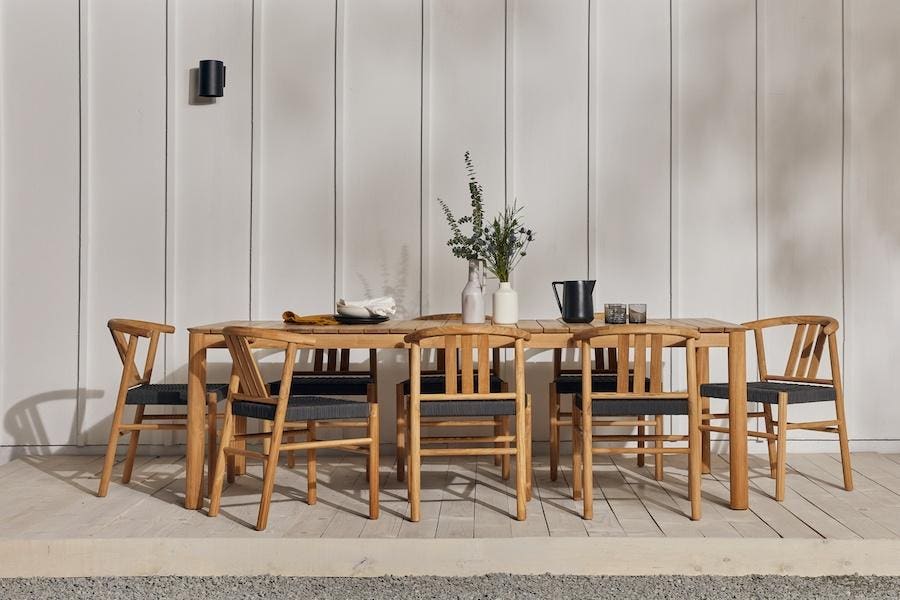One of the biggest design trends in recent years is sustainability. Whether it’s choosing non-toxic materials, quality products built to last, or ethical sourcing—consumers are being more thoughtful about how their purchases impact the environment.
This especially applies to outdoor spaces, explains Nick Arambula co-founder of Neighbor. “Sustainability is resonating with consumers because there is a growing awareness of the impact of consumer choices on the environment. As people become more conscious of their ecological footprint, they are seeking products and brands that align with their values. Sustainable practices demonstrate a commitment to reducing environmental impact, which appeals to consumers who want to make responsible choices.”
Here’s what you need to know about creating an outdoor space that’s both stylish and sustainable.
Accessibility Is Key
Mindy O’Connor, principal architect and founder of Melinda Kelson O’Connor Architecture & Interiors in Philadelphia, Pennsylvania has found her clients wanting more sustainably designed outdoor spaces. But sourcing sustainable pieces can often be impractical. “One challenge is choosing elements that are sustainable but also can compete with more mass-produced items in terms of cost and speed of delivery,” she explains.
Fast furniture has been a part of the problem, throwing a wrench into consumer expectations. People want things quickly, which isn’t always possible with high-quality, more sustainably made pieces, explains the designer. “The rise of cheap, fast furniture itself and the cultural acceptance of tossing out furniture as trends change or people relocate is often at odds with sustainability goals.”
Arambula also saw this pain point, which is why he started Neighbor in 2020. The mattress industry veteran sought to create sustainable, stylish pieces that were high quality while offering exceptional customer experience. The brand currently offers a full line for every type of outdoor space including dining furniture, lounge chairs and sofas. These pieces have a modern flair yet surprisingly timeless feel.
Sustainable Materials Are Everything
The key to sustainability is choosing the right materials. O’Connor tells me, “[Sustainable furniture should be made with] materials that focus on health and are not toxic to humans and animals, ethically produced—prevents deforestation and doesn’t exploit workers, will ultimately reduce landfill waste, [and ] focused on clean manufacturing.”
Teak wood in particular has become a popular choice for consumers. “It’s water-resistant, and rot-resistant meaning that it will last a long time outdoors. Teak wood’s natural oils repel water, making it resistant to most forms of wood rot, fungi, and pests,” says Arambula. “It also happens to be a beautiful wood that only looks better with age. For centuries, teak was the wood of choice for shipbuilders because of its durability and unique water-resistant qualities.”
Additionally, Neighbor uses other sustainable materials including rope. “Rope is a sustainable material because it is highly durable and can withstand outdoor conditions without fading in the sun. The use of rope in our dining chairs specifically also reduces the need for wood and cushions while still giving you that upholstered feel, minimizing waste and making it an eco-friendly alternative. The tight weave also adds to the stability to the seat aiding in the structural integrity of the design.”
Look For FSC-Certification
Another key to sustainability is choosing FSC Certified products. The Forrest Steward Council is an organization that provides third-party certification for both sustainability and ethical sourcing. “The FSC promotes responsible management, and is even backed by groups such as WWF, Sierra Club, Greenpeace, Natural Resources Defense Council, and National Wildlife Federation,” explains Neighbor’s cofounder. “With FSC certification, we can guarantee that our teak is coming from sustainably managed forests that promote biodiversity, protect wildlife, and support the economies of communities near the forests and plantations.”
If FSC-certified products are not possible O’Connor advises looking for furniture made with renewable and nontoxic materials. “Avoid materials that cannot be repaired, recycled, or restored, which might be those that contain too many composite materials, toxic finishes, or overly complex production methods.”
Aesthetic Impacts Sustainability
An additional factor that makes furniture sustainable is aesthetics. The architect suggests going with pieces you won’t be tired of next season. “Choose new furniture that is timeless, and avoid trends. Look at what you have that can be refinished, repainted, or rearranged, and explore whether it can have a second or third life. Reupholster or create new cushions for existing pieces.”
Neighbor has a modular design, meaning additional pieces can be added. So, it can grow with a family or a sectional can become two smaller pieces for those who downsize.
Don’t Replace Furniture, Just Accessorize
The best way to make outdoor spaces more sustainable is to choose versatile pieces unlikely to look dated next season. Then switch up accessories to keep up with the trends. One way to do this is with pillows. Changing out pillows seasonally can give an outdoor space a new look.
Then consider how you can refresh your backyard or patio. “Outdoor spaces can be transformed as much by plantings, surfaces, and lighting as they can by furnishings. Look for ways to change the space with uplights, hanging string lights, or fixtures,” says O’Connor. Planters or in-ground planting can completely alter the feeling and shape of an outdoor space even without any new furniture pieces. There is nothing more colorful or harmonious than natural plants and flowers.”
Read the full article here













